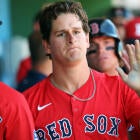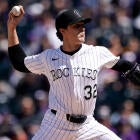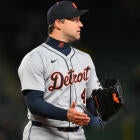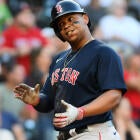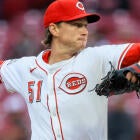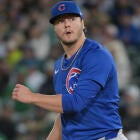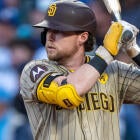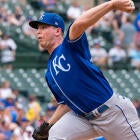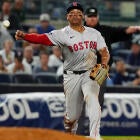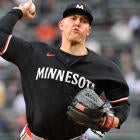
Not every prospect who we would have liked to see on an opening day roster actually made it onto an Opening Day roster, but the tide can turn quickly. Just three weeks ago, nobody imagined Cam Smith would be on the Astros, and certainly not in right field.
Rosters aren't stagnant either. Just because someone isn't there for Game 1 doesn't mean he's far off, and you may even consider dedicating a bench spot to someone who could soon make that leap. That's the gist of this article. You wouldn't want to stash too many prospects and you wouldn't want to do it in too shallow of a league, passing up other upside plays who are of more immediate use, but when the pickings are slim, a little speculation can go a long way.
Note that the only players in consideration here are those who meet the technical definition of a prospect, which would exclude Zebby Matthews, Evan Carter and Noelvi Marte, who happen to be in the minor leagues now but have too much major-league experience to qualify as prospects. (For what it's worth, I've listed those three in the order I'd stash them, and I'm not sure Marte would crack this top 12 even if he did qualify for it.)
Note also that while I think Andrew Painter is arguably the top pitching prospect and has a crystal clear timeline for a promotion (i.e., once he's built up in June), I've excluded him because it would be difficult to justify stashing a prospect for 2-3 months in a redraft league. No guarantees any of these 12 will be up within that time frame, but at least they have a chance. Still, if you'd prefer to stash Painter over Nos. 2-12 on this list, I get it.
1) Roman Anthony, OF, Red Sox
2024 minors: .291 BA (454 AB), 18 HR, 21 SB, .894 OPS, 79 BB, 127 K
Kristian Campbell may have secured a major-league job, but Roman Anthony is generally regarded as a better prospect, thin though that margin may be. Even while fighting an illness early in spring training and losing some weight, Anthony still had a fine showing, and there isn't a real case for him having more to accomplish at Triple-A seeing as he hit .353 with a 1.022 OPS in the second half there, cutting his strikeout rate to 21.4 percent as compared to 25.6 percent previously. The problem is that the Red Sox have too many capable alternatives, but there are a number of ways that could change. Wilyer Abreu could fall short offensively, or Ceddanne Rafaela may be needed at shortstop again if (and when) Trevor Story goes down.
2) Bubba Chandler, SP, Pirates
2024 minors: 10-7, 3.08 ERA, 1.02 WHIP, 119 2/3 IP, 41 BB, 148 K
Chandler's control took a leap last year to make him a consensus top-five pitching prospect, and though we didn't see much of him this spring, he's certainly on the precipice of the majors. My suspicion is that the Pirates are handling him similarly to the way they handled Paul Skenes last season, giving him just a couple token appearances in spring training and then using all of April to build him up. That obviously worked out well for Skenes, and with the way the Pirates rotation has been shaping up, having lost Jared Jones and Johan Oviedo to injury already, they'll be aching for Chandler by the time he's ready to go. Chandler will obviously have to hold up his end of the bargain during the ramp-up phase, but the timetable seems pretty clear if he does.
3) Quinn Mathews, SP, Cardinals
2024 minors: 8-5, 2.76 ERA, 0.98 WHIP, 143 1/3 IP, 49 BB, 202 K
Mathews got more run than Chandler in spring training and made the most of it, allowing no runs in six innings with nine strikeouts. More notable than the performance, even, is the fact that his velocity gains carried over from his breakthrough 2024 season, when a 3-4 mph bump on his fastball led to him becoming the minor-league strikeout leader. I feel more confident in Mathews' ability to take on a major-league lineup today than I do Chandler's, but the reason I rank Mathews a spot lower is because he has more arms standing in his way. Michael McGreevy already has major-league experience and was a late cut in spring training, and Steven Matz is currently pitching out of the bullpen. Mathews is more talented than both and could force the issue based on that, but it's not clear how long it would take.
4) Zac Veen, OF, Rockies
2024 minors: .258 BA (233 AB), 11 HR, 21 SB, .805 OPS, 30 BB, 67 K
Veen came within a stone's throw of making the roster this spring. He deserved it more than Jordan Beck after slashing .270/.352/.460 with nine stolen bases, and it actually looked like both would make it after the Rockies traded Nolan Jones to the Guardians. That's a big reason why Veen emerged as a late-round target in five-outfielder leagues, and if you happened to select him in such a draft, I guess I'm advising you to hang on. Whatever service-time games the Rockies are playing with him will be of the short-term variety, and the reason I know that is because the placeholder is Nick Martini, a 34-year-old journeyman with no upside to speak of. By mid-April, the Rockies will have secured an extra year of control, so perhaps that's what they're aiming for. Veen may not have quite the ceiling of some of these others, but he's a prolific base-stealer who makes high enough quality contact to get the most out of what Coors Field has to offer.
5) Jordan Lawlar, SS, Diamondbacks
2024 minors: .318 BA (85 AB), 2 HR, 6 SB, .900 OPS, 14 BB, 23 K
This makes two years in a row for Lawlar on this list, and I'm a little surprised it's not three. The guy has been knocking on the door for what feels like forever, even appearing in 14 major-league games late in 2023, but injuries have slowed him down while other players have blocked his path. On that second score, the Diamondbacks signed shortstop Geraldo Perdomo, heretofore thought to be a placeholder, to a four-year extension in the offseason. Eugenio Suarez is back for another year after rediscovering his stroke in 2024. To my knowledge, there are no plans to try Lawlar in the outfield. Why stash him at all? Because he's ready. He's beyond ready, and an injury to anyone on the Diamondbacks infield -- or at DH, for that matter -- likely thrusts him into a starting role.
6) Dalton Rushing, C, Dodgers
2024 minors: .271 BA (420 AB), 26 HR, .896 OPS, 64 BB, 103 K
The problem for Rushing, who has the look of an OPS hog at the most offense-starved position, is that the Dodgers have a player locked up through 2033 at that same position. They have, however, acknowledged that Will Smith may need more time off this year to manage a lingering bone bruise in his ankle -- an injury that likely contributed to him batting .216 with a .708 OPS from May 1 on. Does that mean we're holding out for a backup catcher role for Rushing? No, because the Dodgers seem to recognize that his bat is ready for the majors and have shown a willingness to be creative to get it there, having him play mostly left field toward the end of last season and giving him exposure to first base this spring. Could a hybrid role, where he backs up Smith at catcher while getting occasional starts elsewhere, be in the offing? Seems logical to me.
7) Jac Caglianone, 1B, Royals
2024 minors: .241 BA (116 AB), 2 HR, .690 OPS, 7 BB, 26 K
Going into spring training, I wouldn't have guessed Caglianone would rank so high on this list. But that, as they say, is why they play the games, and few players did that better than him this spring. Merely looking at the numbers will tell you that much. Not only did he bat .500 (9 for 18) with more walks (five) than strikeouts (four), but of his nine hits, six were for extra bases, including three home runs. We only have data for two of those home runs, but both were in excess of 435 feet and 114 mph, backing up the reports of the huge excess velocities he generated in college. With Vinnie Pasquantino locked in at first base and the DH spot needed to keep Salvador Perez playing every day, there doesn't seem to be a clear path for Caglianone, but the Royals have floated the possibility of trying him in the outfield.
8) Marcelo Mayer, SS, Red Sox
2024 minors: .307 BA (300 AB), 8 HR, 13 SB, .850 OPS, 30 BB, 66 K
We heard plenty about Kristian Campbell this spring and hear plenty about Roman Anthony pretty much always, but the OG of the Red Sox's vaunted prospect class is Marcleo Mayer, their first-round pick in 2021. And of the three, he's the one who looked most capable this spring, slashing .333/.455/.528 in 44 plate appearances. I don't think his ceiling is quite as high as the other two, with the best-case outcome being something like the non base-stealing version of Bo Bichette, but that's plenty good enough to make Mayer worth your while in leagues that make use of an additional middle infield spot. I've already made the case for Anthony getting called up if and when Trevor Story goes down, but because Mayer is himself a shortstop, the path of least resistance in that scenario would actually be ... him.
9) Nick Kurtz, 1B, Athletics
2024 minors: .368 BA (38 AB), 4 HR, 1.283 OPS, 12 BB, 10 K
Kurtz got only 12 games in the minor leagues after being drafted fourth overall last year, but he looked so good in them that he's already being moved to Triple-A for the start of 2025. And it's obviously just a step up to the majors from there. Whether a path opens up for him depends on how much Tyler Soderstrom catches (freeing up at-bats at first base) and how much Brent Rooker plays the outfield (freeing up at-bats at DH), but if Kurtz forces the issue, I think the Athletics will find a way to make it work. It could take some time to sort out, possibly until midseason, which is why Kurtz is a little further down this list, but when the time comes, I think he'll basically be the second coming of Matt Olson.
10) Coby Mayo, 3B, Orioles
2024 minors: .293 BA (358 AB), 25 HR, .964 OPS, 42 BB, 102 K
2024 majors: .098 BA (41 AB), 0 HR, 4 BB, 22 K
Mayo didn't muster much during an extended look this spring, striking out more than 28 percent of the time and going homerless in 46 plate appearances, which only matters because he was so bad during a major-league trial last year, going 4 for 41 with 22 strikeouts. We often refer to prospects having nothing more to prove at Triple-A, which would seem to be the case for Mayo after the way he performed there the past two years, but clearly, there's something for him to work on still. I'm mostly explaining why he's lower on this list than you might imagine given that he does have some major-league experience already, and that little exposure will indeed make him easier to call up should the need arise. Given that the Orioles are already struggling to find at-bats for Heston Kjerstad, though, I don't gather there's much urgency for Mayo.
11) Christian Moore, 2B, Angels
2024 minors: .347 BA (101 AB), 6 HR, 2 SB, .984 OPS, 9 BB, 29 K
The Angels are notorious for rushing their top draft picks to the majors, and there were reports this spring that they might do the same with Moore if Luis Rengifo's hamstring injury turned out to be a bigger deal than it was. I'm not sure it would have gone so well, though. Moore struck out in 33 percent of his 52 plate appearances this spring while collecting just two extra-base hits, neither of them home runs. His 25 games in the minors after being drafted last year were spectacular, but all six of his home runs came in the first eight of those games. He hit .246 (17 for 69) with a 33 percent strikeout rate thereafter. There are some impressive tools here, but they are in need of some polish. Still, it's hard to imagine the Angels will leave him in the minors all year long.
12) Agustin Ramirez, C, Marlins
2024 minors: .267 BA (476 AB), 25 HR, 22 SB, .845 OPS, 61 BB, 102 K
Ramirez is at an age (23) and a stage of development that would suggest he's simply biding his time in the minors, and seeing as Nick Fortes is the Marlins' No. 1 catcher heading into the season, it's clear they've left the path open for him. Even if you say he can't cut it behind the plate, which is a fair critique, his main obstacle at first base is Matt Mervis, which might as well be no obstacle at all. Ramirez, who came over from the Yankees in the Jazz Chisholm trade, has power that plays to all fields, a good understanding of the strike zone, and even an aptitude for stealing bases even though he's not particularly fast. The Marlins aren't playing for anything and have no incentive to rush him, but as long as he holds up his end of the bargain, his promotion this year is inevitable. Notably, he'll be catcher-eligible for Fantasy regardless of where he's actually playing.
![[object Object] Logo](https://sportshub.cbsistatic.com/i/2020/04/22/e9ceb731-8b3f-4c60-98fe-090ab66a2997/screen-shot-2020-04-22-at-11-04-56-am.png)







